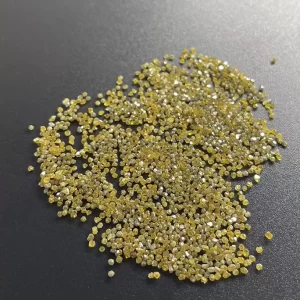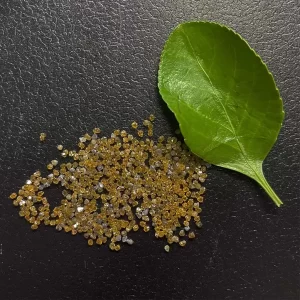Yellow Uncut Synthetic HPHT Single Crystal Diamonds For Cutting Tools
Industrial Usage Yellow Uncut Synthetic Hpht Single Crystal Diamonds For Cutting Tools
Hpht Single Crystal Diamonds Description
Lab diamonds are real diamonds. Carbon is the main element of natural and laboratory-grown diamonds. The chemical and physical properties of synthetic diamonds are same as natural diamonds in terms of hardness, thermal conductivity, and strength.
High temperature and high pressure (HPHT) and chemical vapor deposition (CVD) are the two most commonly used growth methods in synthetic diamonds industrial. High temperature and high pressure exert intense heat (about 1500 degrees Celsius, or 2700 degrees Fahrenheit) and pressure (1.5 million pounds per square inch) on the diamond seed and the carbon atoms surrounding it. Chemical vapor deposition, on the other hand, uses less heat and pressure, but introduces a mixture of chemical gases, which decomposes and hardens into crystalline carbon atoms.
Diamond has always been favored by the scientific and industrial circles, and is widely used in optics, semiconductor, oil exploration and other fields. Diamond is an excellent optical material with high transmittance from X-ray to microwave, high hardness, high thermal conductivity, high chemical stability and low coefficient of expansion. Also diamond is an ideal semiconductor material with wide band gap, high carrier mobility, high breakdown voltage and high thermal conductivity.
Diamond Size: 1-4mm
Application: Diamond tools making
HPHT Single Crystal Diamonds For Cutting Tools
Compared to polycrystalline diamonds, HPHT single crystal diamonds are more expensive to produce. These diamonds are ideal for cutting smart phones, because they guarantee an inscribed square edge length and a 75% minimum nominal plate length. They are also produced through a high-pressure, high-temperature synthesis process. Their quality is also carefully controlled. This article discusses the benefits and disadvantages of HPHT single crystal diamonds for cutting tools.
CVD technology
CVD technology for HPHT single crystal diamond cutting tools produces high-purity diamonds that have a superior hardness and a high flexural strength. The CVD process yields diamonds with a high purity and toughness, but can result in considerable weight loss due to polycrystals. Typical CVD defects are non-crystallized carbon inclusions.
The benefits of synthetic CVD diamond are outstanding spectral transmission, highest thermal conductivity and minimal radiation damage. They are a good choice for applications such as ATR prisms, Raman laser crystals, and extra and intra-cavity laser cooling. They exhibit highly predictable behavior. They can be made in various shapes, including round, radiant, and cushion. The corners of round diamonds retain small fragments. These fragments can be cut to make sieve diamonds.
During CVD growth of single-crystalline diamonds, multilayered epitaxial layers are grown on a quartz bell jar CVD reactor at 2.45 GHz. HPHT diamond seed substrates with a nitrogen content of 60 ppm were used. Hydrogen and methane gases were used as process gases. After etching, the seed substrates were mechanically polished to an average roughness of 3 nm. These flat diamonds are acid-cleaned to remove residual surface material.
Nitrogen-doped diamonds also have high toughness. These diamonds are stronger than other single crystals based on CVD technology. The nitrogen-doped layer has a higher compressive stress than the buffer layer, a factor that is about two to four times higher than the undoped CVD single crystal diamonds. Further improvements will include growth of thinner and nitrogen-doped CVD single crystal diamonds to obtain higher fracture toughness.
The deposition chamber 120 also includes a stage 132. The stage is made of a high thermal conductivity material, such as molybdenum. The stage is attached to a holder that can support the diamond 136. Besides the stage, the coolant pipe 132 is used to control the height H between the growth surface of the diamond 136 and the deposition chamber floor 122.
HPHT mono crystal diamond (MCD)
HPHT mono crystal diamond is a synthetic single-crystal diamond made under highly controlled growth conditions. Its superior properties include high thermal conductivity, wear resistance, and plate-like crystals. It is also scratch and wear-resistant. This material is primarily used in high-precision cutting tools. Its use as cutting tools in machining processes is expected to increase over the next several years, especially in the field of medical devices.
HPHT mono crystal diamonds are very hard and look almost identical to natural diamonds. They are created through a process that involves low interaction between adjacent grains and minimal metallic inclusions. They are used for demanding cutting applications, including heat spreaders, wire drawing dies, and cutting tools. Although HPHT mono crystal diamonds are more expensive, they are more durable than SCD and comparatively cheaper. HPHT mono crystal diamonds are the preferred choice for cutting tools in many industries.
The hardness of these mono crystals is also higher than that of natural diamonds. They are more durable and have better edge-to-edge sharpening capabilities. However, this material is extremely expensive, making it difficult to find a high-quality diamond. Therefore, it is important to choose the correct diamond material for the job. HPHT mono crystal diamonds have the highest possible wear and heat resistance.
The emergence of HPHT diamond powders is another promising technology for industrial applications. Graphite-based diamond powders contain a variety of particle sizes with different phase compositions. The graphite-based diamond powders, in particular, consist of 1-3 mm-sized lamellar particles. This type of particle is characterized by a narrow size distribution, and a large number of grains per square millimeter. Compared with the PACVD diamond-coated tools, PCD-inserted tools have better edge performance and longer life.
A typical diamond has an average grain size of about 50 nm. The grain size is typically around 100 nm, and the first-order spectrum includes a sharp diamond line at 1332 cm-1. However, the D and G bands gradually become more pronounced as grain size decreases. Thus, a single-crystal diamond has a FWHM between 1.7 cm-1 and five cm-1.
Residual stresses in MCD lead to micro-chipping
The formation of residual stresses and micro-chipping is associated with diamond cutting. Several recent studies have investigated the formation of surface roughness and residual stresses in diamonds. These studies reveal that the cutting processes are highly coupled and that the tool is subjected to increasing machining forces. The machining process has three distinct phases: the first is pure elastic deformation of the workpiece material. After three nanometers, the workpiece undergoes plastic deformation due to dislocation emission from the top surface of the diamond.
Surface roughness and residual stress are strongly influenced by the machining parameters. The rake angle of the cutting tool and the depth of cut are the key factors affecting surface roughness and residual stress formation. The surface roughness is a product of residual stress formation in single-crystal diamonds. When combined with surface roughness, these processes result in micro-chipping of the workpiece.
In addition to forming residual stresses, single-crystal diamonds are also subject to brittleness due to compressive forces. These forces result in micro-chipping, and it is one of the main reasons for the failure of diamond tools in precision machining. To counteract this problem, the tool should be protected from damage by a thin film.
A molecular dynamics simulation has been developed to better understand this process. Single-crystal diamond tools with different depths and groove widths are studied. The cutting force and the temperature produced during the process are studied in detail. The effects of cutting speed, depth, and crystallographic orientation on material removal are analyzed. The results show the formation of stair-rod dislocations, stacking fault tetrahedrons, and point defects.
Several models have been developed to investigate the formation of residual stresses. The embedded atom method, a model that describes the interaction between workpiece and diamond cutting tool atoms, is one such method. An embedded atom model, or MD simulation, is also used to study the effect of temperature on the micro-chipping process. Once this model is established, MD simulations can be used to study the atom-level details of this process.
Polycrystalline diamond is cheaper to produce
The manufacturing process of PCD involves fused diamond with a carbide substrate. The result is polycrystalline diamond (PCD), which offers a high wear resistance factor. Compared to carbide, diamond tools can last 25 times longer. A CVD diamond tool’s advantage is the long flute length. Another advantage is its specific tool geometry. If you’re looking for cutting tools, PCD may be the right choice for you.
The cost of polycrystalline diamond is lower compared to tungsten carbide, which is widely used for precision cutting. But it is not the only advantage of this material. While both materials are durable and hard, PCD is more cost-effective for a wide range of applications. For example, in mold manufacturing, PCD is cheaper to produce than tungsten carbide. The underlying tungsten carbide substrate remains in the PCD drill, meaning it can last longer than its CVD counterpart.
The price of polycrystalline diamond is also lower than that of single-crystal diamond. The former is cheaper to produce for cutting tools, but is not as durable as polycrystalline diamond. This new material is harder to measure, and thus has many scientific uses. It’s also more durable than carbon. When you’re shopping for cutting tools, you can’t afford to waste your money on inferior materials.
Compared to traditional cutting tools, polycrystalline diamond tooling is also better for solid woods, including composite panels. The benefits of PCD tooling increase as the abrasiveness of the material increases. Furthermore, diamond is more effective for cutting composite panels and other materials containing high levels of resin. These are the two main advantages of polycrystalline diamond tooling. They are more affordable to produce and require less care, but polycrystalline diamond has more advantages.
The new synthesized catalyst free polycrystalline diamond compact material was evaluated for its hardness and thermal stability. It also exhibited high wear resistance. The process of producing PCD tools involves the highest electricity input and a high degree of use of tungsten and molybdenum. Full WC-Co recycling reduces both the amount of carbon used and the carbon footprint, and it shows a high degree of environmental improvement. The main drawback of PCD tools is their sensitivity to titanium alloys, and they cannot be used for machining these materials.
Yellow Uncut Synthetic HPHT Single Crystal Diamonds For Cutting Tools
















